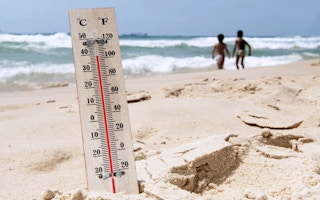The so-called hiatus in global warming will probably make no difference to the world in the long run, according to Australian scientists.
Using computer models to take the planetary temperature in 2100, they found that one set of models incorporated the slowdown, but others did not. In the end, the difference was barely significant: less than 0.1°C.
The hiatus is a measurable slowdown in the rate of increase in average global temperatures since the turn of the century.
But since, under the notorious business-as-usual scenario, average planetary temperatures in 2100 will be a predicted 5°C higher than at the start of the Industrial Revolution around 200 years ago, the conclusion is that the slowdown is fleeting.
Drastic steps
In the end, and unless the planet’s governments take concerted and drastic steps to reduce greenhouse gas emissions from fossil fuels, the outcome will be the same.
The study, the authors say in the journal Nature Climate Change, shows that the slowdown merely reflects short-term variability.
“
Our research shows that while there may be short-term fluctuations in global average temperatures, long-term warming of the planet is an inevitable consequence of increasing greenhouse gas concentrations.
Matthew England, chief investigator at the Centre of Excellence for Climate System Science at the University of New South Wales
“Our research shows that while there may be short-term fluctuations in global average temperatures, long-term warming of the planet is an inevitable consequence of increasing greenhouse gas concentrations,” says Matthew England, chief investigator at the Centre of Excellence for Climate System Science at the University of New South Wales. “This much-hyped global warming slowdown is just a distraction from the matter in hand.”
It may be a distraction, but Professor England is one of an increasingly large set of researchers puzzling over the mechanisms that may be at work.
There is – and climate scientists have confirmed this repeatedly over the last 100 years – a direct link between the planet’s temperature and the levels of carbon dioxide and other greenhouse gases in the atmosphere. In the last 30 years of the last century, planetary average temperatures rose steadily by the decade.
In the first 15 years of this century, the rise has been much smaller, even though the emissions have been greater.
Thirteen of the 14 hottest years ever recorded have fallen in this century, and 2014 was the hottest of them all, but that hasn’t stopped climate scientists from trying to account for the apparent slowdown − perhaps with an aspect of the climate machinery they have so far overlooked.
One group recently suggested that a natural cycle of cooling in the Antarctic – a cycle much longer and slower than the sketchy data from the southern continent can confirm – has simply masked a continued rise in global temperatures.
Another has pointed to a relatively recent increase in volcanic eruptions that might have delivered enough sulphur aerosols into the atmosphere to block sunlight and to imperceptibly counter the warming trend.
Temporary storage
Braddock Linsley, research professor at the Lamont-Doherty Earth Observatory at Columbia University, New York, and colleagues proposed that the “missing” heat might be in temporary storage in the deep oceans.
And Professor England and colleagues proposed a link between the Pacific trade winds and a natural pattern of ocean circulation − a slow movement sometimes called the Pacific Decadal Oscillation (PDO) − that might be at work, overturning the ocean waters, cooling the surface and burying the warmth.
Now Dr Linsley and colleagues report in Geophysical Research Letters that the trade winds theory might provide at least part of the explanation.
They have been looking at sea surface temperatures in the southern Pacific back to 1791, as witnessed by the growth of the coral reefs, and have identified a pattern of cyclic change with a period of perhaps about 25 years.
When the PDO goes into reverse, the so-called warming hiatus could end. If the present cycle began around 1999, then it could end quite soon − as early as 2020.
Dr Linsley told the Climate News Network: “There is already some evidence that the PDO may have started reversing late last year.”

















